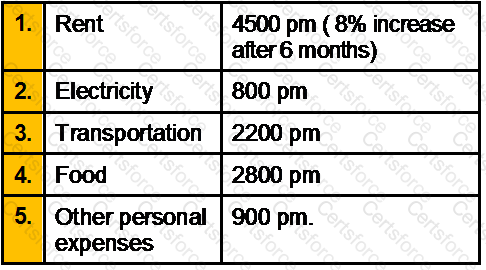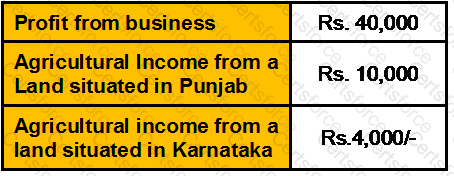Consider two stocks, A and B

The returns on the stocks are perfectly negatively correlated.
What is the expected return of a portfolio comprising of stocks A and B when the portfolio is constructed to drive the standard deviation of portfolio return to zero?
Mr.Singhvi is a senior manager in a advertising firm in Mumbai. During the previous year 2011-12, he gets the following emoluments: Basic salary Rs.30, 000 per month, dearness allowance: 10% of basic salary, city compensatory allowance: Rs.300 per month, children education allowance:Rs.500 per month (for 3 children), house rent allowance: 20% of salary (rent paid Rs.2000 per month).
He gets Rs. 21,000 as a reimbursement from his employer in respect of medical expenditure incurred on treatment of his wife in a private clinic. Besides, he gets Rs.12, 400 as reimbursement from the employer in respect of books and journals purchased by him in discharging his official work. He contributes 11% of his salary to statutory provident fund to which a matching contribution is made by the employer. During the year, he spends Rs.15, 000 for maintaining a car for going to the college.
Determine his net income under the head of salaries.
Mr. Sushil, is 35 years old and working as a physician in a private hospital. He will retire at the age of 60. He is saving Rs. 30,000/- p.a. at the end of every year for past 5 years and will continue to save the same up to his retirement @ 7% p.a. His annual expenditure is Rs. 3,00,000/-. Life expectancy of Mr. Sushil is 75 years. On retirement, rate of interest is expected to be 6%. Calculate on retirement how much he can spend per annum if he leaves Rs. 5,00,000/- as estate for next generation?
Saurabh contributes Rs. 10,000 every year starting from the end of the 5th year from today till the end of 12th year in the account that gives a ROI of 7.75% p.a. compounded half yearly. Calculate the Present Value of his contribution today.
An individual has recently purchased a house worth Rs. 40 lakh for self-occupation by availing housing loan of Rs. 28 lakh at 9.25% p.a. rate of interest. The tenure of loan is 18 years. He has Rs. 12 lakh financial assets at present. He is expected to save annually Rs. 2 lakh which he invests on a quarterly basis beginning a quarter from now in an instrument which is expected to provide return of 9% p.a. What would be his net worth five years from now? The value of the house which is for consumption purposes is not considered in the net worth so arrived.
The expected return and standard deviations of stock A & B are:

Amit buys Rs.20,000 of Stock A and sells short Rs.10,000 of Stock B using all the Proceeds to buy more or Stock A. The correlation Between the two securities is .35. What are the expected return & standard deviation of Amit’s portfolio?
Consider the following information for three mutual funds

Risk free return is 7%. Calculate Treynor measure?
Azhar aged 30 is a disciplined investor. He has started depositing Rs. 25,000 every year in an account that pays a return of 9% every year. He plans to increase his contribution by Rs. 5000 every year till his age 50. Calculate the amount he would be having in his account at this age.?
What amount needs to be deposited today in an account that would pay Rs. 1,10,000 per year for the first 10 years and Rs. 2,25,000 for the next 5 years. If the ROI for the first 10 years if 10.75 % p.a. compounded annually and 13% p.a. compounded quarterly for the balance period.?
Pushkar completed the construction of a house property on 14.8.2008 with borrowed capital of Rs.800000 @ 12%. The loan was taken on 1.4.2006 and is still outstanding. The house was used for his own residence during the entire FY 10-11. Deduction U/S 24(B) for interest on borrowed capital for FY shall be
Calculate the death claim amount if the assured dies in the 25th year of the policy. Money back policy with SA of Rs. 50000. Term is 25 years. Survival benefits of 10% each paid at the end of 5th , 10th, 15th, and 20th years. Accrued bonus of Rs. 500 per thousand of SA.Interim bonus of Rs. 75 per 1000 of SA.
Alok a 28 years old person has joined SABH on 1/07/2006. His monthly salary (net salary) after deduction is payable Rs. 22500/. His monthly expenses details are as follows:

Assume Alok takes a flat on rent from 01 /07/2006. On 01 /07/2006 he has cash in hand Rs. 1450/-. He starts paying insurance premium from October @ Rs. 2500/- pm. His investments in Mutual fund SIP are Rs. 3000/- pm for a 6 month period. What will be his cash in hand on 31/03/2007.?
Compute Gross Total income and amount of loss allowed to be carried forward to next year:

Consider the following information for three stocks, Stock A, Stock B, and Stock C. The returns on each of the three stocks are positively correlated, but they are not perfectly correlated.

Portfolio X has half of its funds invested in Stock A and half invested in Stock B. Portfolio Y has invested its funds equally in each of the three stocks. The risk-free rate is 5%, and the market is in equilibrium.
Which of the following statements is/are correct?

Savitri is 30 years old. She saves Rs. 14,000/- p.a. (year end) in FD 8.75% p.a. compounded annually until she retires at age 58. Her life expectancy is 80 years. What would be her corpus at the time of retirement? What is the fixed amount she can withdraw at the beginning of each year, until age 80, in case she wishes to exhaust the whole corpus? Inflation is 5%.
Mr. M is an employee of Z Ltd. His basic pay is Rs.24,000 p.a., Dearness Allowance Rs.12,000 p.a; Medical Allowance (fixed) Rs.10,000 p.a.; Conveyance Allowance Rs.6,000 p.a.; Professional Tax deducted from his salary Rs.1,000 p.a.; Free lunch provided during office hours valued at Rs.12,000 for a 300-working day year; free education for two children in a school owned and maintained by the employer – school tuition fee for both the children is estimated at Rs.18,000 p.a.
What is Net Income of Mr. M and examine whether he is a specified or non-specified employee?
Yami Ltd is a one of most accredited tours and travels company in India. It pays dividend per share of Rs. 0.24 on reported earning per share of Rs. 0.512 in 2011. The firms earnings per share have grown at 8% over the prior 5 year but that growth rate is expected to decline linearly over the next 5 years to 3%, while the payout ratio remains unchanged. The beta for the stock is 0.9. The risk free rate is 4.2% and the market risk premium is 4%.
Roger deposits Rs. 10,00,000 in a bank account on 1st March 2005 and another Rs. 5,00,000 on 1st March 2011. He wants to withdraw all of this money with interest on 1st March 2015. If the account pays ROI of 11% P.A. compounded quarterly what amount can he withdraw from this account?
Ram purchased a house in Mumbai in March 2004 for Rs.12,50,000. In April, 2011 entered into an agreement to sell the property to Shyam for a consideration of Rs.19,75,000 and received earnest money of Rs.50,000. As per the terms of the agreement, the balance payment was to be made within 30 days of the agreement. If the intending purchaser does not make the payment within 30 days, the earnest money would be forfeited. As Shyam could not make the payment within the stipulated time the amount of Rs.50,000 was forfeited by Ram. Subsequently Ram sold the house in June,2012 for Rs. 21,30,000. He paid 2% brokerage on sale of the house. Calculate the capital gains chargeable to tax for the assessment year 2012-13. [CII-12-13: 852,11-12: 785,10-11:711,03-04:463]
Mr. M is an area manager of M/s Allwin Ltd. During the financial year 2007-08, he gets the following emoluments from his employer:

Compute taxable salary of Mr. M for the Assessment year 2008-09.